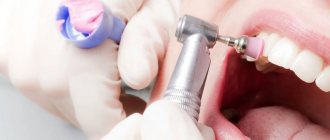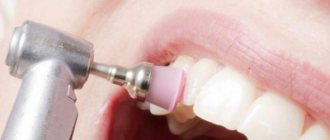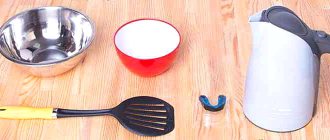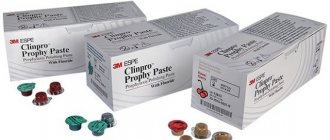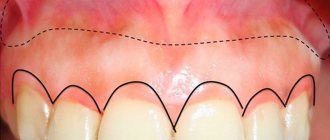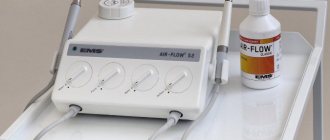Date of publication: 09/28/2018
Tooth filing has been used in dentistry since the 19th century. At that time, the procedure helped treat caries by mechanically removing damaged tissue. Today the technique is used to eliminate other problems, mainly aesthetic ones.
For example, teeth can be filed if one or more units stand out from the general row due to their increased length. Filing can also help with small chips on the edges of the tooth.
In what cases is tooth filing used?
There are different opinions about the advisability of the procedure. It is mainly carried out in the following cases:
- When the upper incisors or canines stand out too much. This not only disrupts aesthetics, but can also interfere with proper bite. In this state of affairs, the teeth can be shortened a little so that they fit better into the dentition.
- If there are small chips on the edges of the teeth. A slight grinding of the enamel will help smooth out the edge.
- If there are sharp corners. Sometimes, due to anatomical features, the front teeth may have protruding parts. They may not look aesthetically pleasing or even damage the cheek.
- For orthodontic bite correction. Sometimes teeth are filed down on the sides to make it easier to move them into the correct position. This is important when installing braces if your teeth are very crowded.
- Filing down the front of the teeth is used when installing veneers. The teeth are also ground down before crowns are installed.
The advisability of filing is determined individually only at the appointment of a specialist.
Cases in which you can straighten teeth without braces
The braces system is the most effective, fastest and painless method for straightening crooked teeth, but many people refuse it for many reasons: they are embarrassed, afraid of discomfort or discomfort associated with eating or while talking.
But there are cases when a person can correct his bite without braces:
- Crooked teeth are only a couple of teeth, not an entire row, so there is no need to wear a complex system;
- The bite only slightly deviates from the norm, but if the bite is open, then braces are still necessary;
- A slight crooked tooth needs to be quickly corrected;
- A person with a “dental” problem is allergic to the metal components that are in braces;
- The gums are located too low, and there is a high probability of injuring them due to the locks of the brace system;
- The patient cannot or does not want to adhere to the rules of wearing and caring for braces;
- The patient wants to look perfect at work or in everyday life, so the use of braces in this case is excluded;
- The patient’s work involves clear and excellent diction (radio DJ, TV presenter, teacher), so he must refuse to wear braces.
Expert opinion
Roman Borisovich Alekperov
orthopedic dentist
Experience: 24 years
If there are indications for filing teeth, it is important to entrust this procedure to an experienced dentist who will correct the aesthetic defect and not cause harm to the teeth. Self-filing is impossible and extremely dangerous - you can seriously damage the tooth, and in the future you will have to resort to microprosthetics or crown prosthetics. There is also a high risk of injury to the mucous membrane and infection.
Contraindications
The necessity and admissibility of filing teeth is determined by the dentist individually in each case, since the procedure is quite labor-intensive and can be traumatic in some situations.
For this reason, sewing hard fabric is contraindicated in the following situations:
- increased abrasion of enamel;
- hyperesthesia;
- bruxism;
- presence of bad habits - frequent chewing of seeds and nuts, opening bottles with teeth;
- high risk of injury to the incisors, for example, boxing and other types of wrestling.
How is filing done?
The technology varies depending on the purpose for which the procedure is performed. The process includes a number of steps:
- - Diagnostics. The doctor determines which teeth will be filed and for what purpose. To do this, a visual inspection is carried out, the cause is studied, and the method of performing the procedure is determined.
- — The area in which manipulation is necessary is determined. For this, carbon paper, wax plates, and special aerosols can be used. This helps to highlight or color an area that, for example, prevents the jaws from closing properly. In difficult cases, a plaster model of the jaw can be made.
- If the procedure requires significant removal of hard tissue, anesthesia is performed.
- Sawing is done using a diamond bur. On chewing teeth, a small layer of enamel on the protruding tubercles can be filed away. If we are talking about incisors, the movements are multidirectional and depend on the situation.
- After the procedure, the surface that was manipulated is polished. Also, remineralizing substances can be applied to the surface of the teeth, as well as compositions to strengthen the surface and reduce sensitivity.
When filing teeth, the thickness of the enamel in the treated areas changes. This may cause increased sensitivity. Usually this is a temporary phenomenon and in the first days it is necessary to refrain from eating hot and cold foods so as not to provoke discomfort and pain. If the problem does not go away over time, you should consult a doctor.
Aligners (aligners)
An aligner is a mouth guard made of silicone or soft plastic that exactly follows the contours of the teeth and works like a brace system, albeit slowly but effectively straightening the teeth. Despite the proven effectiveness of aligners, they are not used so often, mainly to correct bites.
The advantages of this method:
- Almost invisible on the teeth;
- Easy to remove while eating or brushing your teeth;
- Does not cause discomfort;
- There are no restrictions on food when wearing a mouth guard;
- Does not cause pain when wearing;
- You can treat “oral” problems while wearing a mouth guard;
- Do not cause allergies;
- Along with straightening, you can also whiten your teeth;
- Has no contraindications.
Disadvantages of this method:
- Not effective for complex problems;
- High price;
- Before eating, food must be removed prematurely and stored properly;
- Long production time (mouthguards are often delivered from abroad).
In order to comprehensively straighten crooked teeth using a mouth guard, you need to go through several stages. First, the dentist takes impressions of the teeth and creates an electronic model. The same layout is necessary at intermediate stages of treatment, as well as at the end of the procedure. For the entire stage of treatment, you need several drops, which should be changed after 2-3 weeks, as prescribed by the doctor.
The patient should wear the mouth guard at least 22 hours a day and remove it only to eat and brush teeth. The duration of treatment is from 6 to 8 months, and in case of prophylaxis.
Diagnostics
Taking an anamnesis is of great importance in diagnosis. The patient is asked whether he has had complaints before. If yes, what treatment was given. The presence of general, especially endocrine diseases is clarified. Find out under what conditions he works.
Then an external examination is carried out. Pay attention to the symmetry of the face and the severity of the folds. Check the functioning of the TMJ. The height of the lower part of the face is assessed by taking special measurements.
When examining the oral cavity, pay attention to the bite, overlap of the incisors, and wear of the teeth. The contacts of the teeth are assessed when the jaws are closed.
To get an accurate picture of the condition of the crowns and bone tissue, an orthopantomogram (panoramic image) and targeted images are taken. According to indications, tomography of the TMJ is prescribed.
Treatment methods
Treatment of pathological tooth wear may include therapeutic and orthopedic techniques. In the first case, there are two options:
- Drug therapy (includes the application of gels and solutions, the use of special toothpaste).
- Restoration (special filling material is used).
Orthopedic treatment involves the manufacture and installation of onlays, dentures or crowns, which restore the normal appearance and functionality of teeth.
Currently, dentists do not agree on the timing of initiation and specific treatment methods in different situations. Most often, drug treatment is used in patients in the early stages of the disease, when the teeth are not yet seriously damaged. For more severe pathology, restorative and orthopedic treatment is indicated.
When preparation for veneers is not necessary
Composite veneering is a method in which a composite layer is applied to the tooth, layer by layer, each time drying it with light. This allows the dentist to adjust the thickness of the veneer, shape the cutting edge and shape. Thanks to layer-by-layer application, the tooth does not need to be turned, the surface is simply ground. In all other cases, the enamel is ground to different depths.
There is another type of overlay that does not require turning - these are lumineers. They are made from special material, only in the USA. You have to wait for delivery, and if 1 lumineer breaks, then you also have to wait until it is made and sent. The Russian analogue, ultranirs, does not need to wait long, but if you need to correct the shape of a tooth, you will still have to grind it down.
Thin veneers can correct only minor defects: lighten teeth a couple of tones, cover dim pigmentation, mask the gap between teeth.
This method has disadvantages:
- Even ultra-thin veneers without grinding enlarge teeth
. With small teeth this is not noticeable, but if the teeth are large, then they visually look too massive. - to correct the shape of a tooth without grinding.
- It is difficult
to smooth the transition of the veneer to the gum ; bacteria can accumulate there, causing caries.
Classification
Teeth abrasion is divided according to:
- Stages
During the active stage, increased abrasion of hard tissue occurs. At the stabilization stage, their condition can be maintained at an acceptable level.
- Distribution
With localized abrasion, the front teeth are most often worn down. In generalized cases, all crowns suffer and the height of the bite decreases. In severe cases, the crown may end right at the gum.
- Shape
With a mixed form, the enamel wears off not only on top, it decreases on all sides. With horizontal, the occlusal surfaces suffer, with vertical, the lateral surfaces.
- Weights:
- Light or 1st degree (within the enamel)
- Transitional or 2nd degree (involving the superficial layers of dentin)
- Pathological or 3rd degree (with exposure of deep layers of dentin)
In grade 1, speech and chewing function are not affected. On the 2nd stage, hypersensitivity and chewing dysfunction appear. On the 3rd, pain in the temporomandibular joint begins. They radiate to the neck and head and can lead to hearing loss and decreased vision.
Symptoms
At first, the disease manifests itself asymptomatically, so it is diagnosed in an advanced state. When tooth enamel is worn away and dentin is involved in the process, patients begin to complain of increased sensitivity. Teeth react to temperature (hot, cold), chemical (sour, sweet), mechanical (touch of a toothbrush) stimuli, causing inconvenience in everyday life.
Dentin destruction leads to root inflammation (periodontitis) and bone tissue atrophy.
The height of the face gradually decreases, pain in the muscles and temporomandibular joint begins. The lower jaw moves upward and backward, the volume of the oropharynx decreases, and less air enters. Problems with the respiratory system begin. The center of gravity shifts, pathological disorders occur in the musculoskeletal system. The quality of life is falling.
